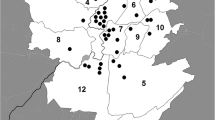Summary
-
1.
A list has been compiled of the species of food and container plants found in the market at Tehuacán, Puebla, Mexico, during a 10-day period in March, 1962. The list comprises 83 species; 56% are New World and 42% Old World, while 2% are common to the tropics of both hemispheres. About 28% of the total number of species are thought to be Mexican endemics.
-
2.
The extensive use made of native food plants suggests that the people of the Tehuacán Valley rely heavily on this resource as a supplement to their dietary regimes.
-
3.
Mexican markets may be utilized as a tool to trace the history of cultivated plants. Ethnobotanical observations suggest that some of the plants found in the market today are retentions from earlier civilizations. This argument is illustrated by a comparison of the cultivatedCucurbita from caves in the Tehuacán Valley with the cultivars found in the market at the present time.
Similar content being viewed by others
Literature Cited
Bailey, L. H., and E. Z. Bailey. 1947. Hortus second. MacMillnn, New York. 778 pp.
Benls, Ralph L. 1946. Cherán: A Sierra Tarascan village. Smithsonian Institution, Institute of Social Anthropology Publ. No. 2. U. S. Govt. Printing Office, Washington.
Brand, D. D. 1951. Quiroga: A Mexican municipio. Smithsonian Institution, Institute of Social Anthropology Publ. No. 11. U. S. Govt. Printing Office, Washington.
Carter, G. F. 1945. Plant geography and culture history in the American South-west. Viking Fund Publ. in Anthropology No. 5. New York. 140 pp.
Cutler, H. C. 1960. Cultivated plant remains from Waterfall Cave, Chihuahua. Amer. Antiquity2(2)6:277–279.
—, and Thomas W. Whitaker. 1961. History and distribution of the cultivated cucurbits in the Americas. Amer. Antiquity26(4):469–485.
Dressier, Robert L. 1958. The pre-Columbian cultivated plants of Mexico. Botanical Museum Leaflet, Harvard University16(6):115–172.
Poster, George M. 1948. Empires children: The people of Tzintzunzán. Smithsonian Institution, Institute of Social Anthropology Publ. No. 6. U. S. Govt. Printing Office, Washington.
Kaplan, L., and R. S. MacNeish. 1960. Prehistoric bean remains from caves in the Ocampo region of Tamaulipas, Mexico. Botanical Museum Leaflet, Harvard University,19(2):33–56.
Lundell, C. L. 1938. Plants probably utilized by the Old Empire Maya of Petén and adjacent lowlands. Mich. Acad. Sci. Papers24(l):37–56.
McBryde, Felix W. 1947. Cultural and historical geography of southwest Guatemala. Smithsonian Institution, Institute of Social Anthropology Publ. No. 4, U. S. Govt. Printing Office, Washington.
Whitaker, Thomas W., H. C. Cutler, and R. S. MacNeish. 1957. Cucurbit materials from three caves near Ocampo, Tamaulipas. Amer. Antiquity22(4):352–358.
Author information
Authors and Affiliations
Rights and permissions
About this article
Cite this article
Whitaker, T.W., Cutler, H.C. Food plants in a Mexican market. Econ Bot 20, 6–16 (1966). https://doi.org/10.1007/BF02861922
Received:
Issue Date:
DOI: https://doi.org/10.1007/BF02861922




